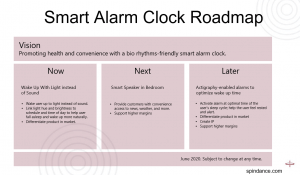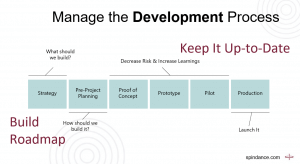Never Tell Me the Odds: A Guide to Roadmap IoT Success
For decades, we’ve helped clients imagine new ways to connect with consumers and build amazing, innovative products. Whether it’s keyless entry systems or smart speakers, we’ve supported countless companies on their journeys toward developing a successful IoT (Internet of Things) solution.
As a quick refresher here’s a summary of IoT: a device that’s linked to the internet and powered by a digital service. Fairly simple. In addition to IoT strategy and consulting, SpinDance builds and manages the digital service. We’re proud to play a part in making life easier or making the world a better place.
We recognize that bringing a product to market takes time. Not to mention, you need a compelling business plan for stakeholders, showing it’s value and worth all the time (see our last post about value proposition). So for many, success in IoT is hard.
We vow to help you beat the odds. To look past statistics. And to see a real, profitable outlook. How do we do this? Well, every journey needs a map, so we always start with a roadmap. Follow along as we guide you through the challenges of IoT projects, best practices for roadmaps, and finally, teach you how to build your Internet of Things roadmap.
IoT Pain Points
Research says almost 75 percent of IoT projects ultimately fail. And yes, that’s disheartening. It’s hard to meet and exceed internal expectations from team members, along with external expectations from consumers. You can’t please everyone, so the odds already feel stacked against you.
Take a memorable scene from Star Wars: The Empire Strikes Back. In the film, our heroes—and pilot Han Solo—are fighting the evil Empire. Han Solo decides to fly into an asteroid field to evade the enemy. But the Android C-3PO tells him the chances of successfully navigating through this asteroid field are 3,720 to one, in which Han Solo iconically replies, “Never Tell Me the Odds.”
At SpinDance, we take our cue from Han Solo. Because there’s good news: the odds for IoT aren’t that bad—not even close. And while we guarantee you’re not looking at 3,720 to one, we can’t promise it’s not an uphill battle. But, thankfully we offer the right tools to overcome mounting challenges and stay the course. To begin, let’s dive deeper and learn why these odds are stacked against us in the first place.
Intellectual Challenges
- Complexity
There are many moving parts in an IoT project (physical device, connectivity, digital software). And these parts must be designed together, so they can integrate and be managed together. But that’s a lot to track. Plus, for many organizations, an IoT project also involves instilling new processes and learning new skills. Thus, adding several layers of complexity.
- Longevity
In our experience, if you’re tracking and adding to an existing device, six months is the shortest time frame you’ll need. Yet, more often than not, we see companies that require nine months, even up to three years. And once a product launches, it needs support. It demands physical upgrades and software updates. So depending on the use case and industry, that timeframe can add three to 10 years (i.e the iPhone).
- Alignment
Perhaps the most significant challenge? Alignment. You need internal alignment with business partners and stakeholders, technical alignment between parts and devices, and finally, customer alignment to ensure the product will satisfy a want or need.
Emotional Challenges
We’ve addressed the intellectual side of challenges, but let’s discuss the more sensitive challenges presented during an IoT project.
Imagine you work for a U.S-based company, and your boss tells you it’s expanding to Europe. You’re likely apprehensive yet excited. You learn this news on a Friday and return to work on Monday thinking you’re heading to Spain. But, you talk with a colleague who believes the location is in Scandinavia. Both are logical conclusions. They’re both in Europe. However, after discussing the matter further, your boss decides it’s too much money—or simply too much of a hassle. So, now the proposed location will be in Florida. Bummer, right?
It’s hard because you had your heart set on Europe—and Florida isn’t that exciting. Ultimately, what began as a great idea is now demoralizing for the company. And in many ways, this is similar to a new IoT initiative. You’re trying to navigate conversations, discuss abstract features, determine what to do first and what market to orient with, and finally, how to support the product. All of this feels much more discouraging without a roadmap.
What Does an IoT Roadmap Do?
Frankly, an IoT roadmap tackles both types of challenges. It helps your team focus on the right goals, establish priorities, plus energize, and motivate everyone. And really, the part about energizing and motivating your team is the most important, especially if you know they’ll be dedicated to a project for almost a decade.
For those who’ve road mapped before, your fear is likely this: everything you develop ends up in a drawer—and never put in play. Well, that’s what we’re here to avoid. Over the years, we’ve adapted a clear methodology from Product Roadmaps Relaunched by O’Reilly. We’ll lay out our inspired framework, but highly recommend this read for further knowledge.
3 Best Practices for IoT Roadmaps
Before we examine specifics of building a world-class roadmap, check out three best practices.
- Keep it High-Level. Be mindful that this is a document for all participants—both inside and outside of your organization (stakeholders, practitioners, partners). It’s not a planning document in the traditional sense, more of a vision that helps everyone understand where you want to go.
- Focus on Outcomes, Not Outputs. Since a roadmap is a vision for where your product should go, it should speak to what you want to accomplish, not so much how you’re going to do it. This provides your team with perspective and latitude for making the right decisions.
- Make it a Living Document. Your roadmap should be changed regularly. Not too often, but it should be an evolving document you can refer to over time.
Elements of a Compelling Roadmap
Now, we’ve offered a few initial notes to keep in mind, but let’s look at the critical elements to include in your roadmap.
Product Vision
You need a guiding light, so this is of utmost importance. This should be a simple statement that’s front and center for everyone. But all in all, keep it short, focused, open-ended, grounded, and compelling.
Timeframe
Key question: how long will the project last? There are a few ways to map out a timeframe, but one tactic can be to break up your project goals into yearly quarters, even into three stages: now, next, and later.
Themes + Business Objectives
It’s also important to tie in themes and business objectives. Your themes connect the benefits and show how the product vision will come to life. Your business objectives will explain the people and processes needed to bolster customer outcomes, nodding to growth and profit.
Supporting Data
Using data to support your roadmap is extremely beneficial. There are many types of supporting data you can include like features/solutions, level of confidence, financial information, and platform considerations.
Disclaimer
Adding a disclaimer may seem silly, but after using this methodology, we’ve found it’s a useful tool to be sure people understand your roadmap. This can be an easy statement such as, ‘June 2020. Subject to change at any time.’
A Smart (Clock) Example
To illustrate all these elements and bring them to life, let’s create a roadmap for a hypothetical smart alarm clock. You’ll find many models of smart alarm clocks on the market, like the Hatch Restore. In our example, the clock has an app connected to it but uses light instead of sound to wake you up. It can also be used to help you wind down in the evening, allowing you to fall asleep and wake up more naturally.
First things first, a targeted vision statement is crafted, “Promoting health and convenience through a biorhythms-friendly smart alarm clock.” Short, sweet, and zeros in on customer value, right? As for the timeframe, it may be easiest to build this out quarterly since it’s an ideal way to help stakeholders and practitioners see the priorities and stages of completion.

When it comes to themes, touch on the value propositions for consumers and how it’s going to generate value for your business. Here are three examples:
- Smart Speaker
Adding a smart speaker to the bedroom provides convenience, allowing consumers to wake and ask for news, sports, or weather reports.
- Light and Sound
This theme combines health and convenience. When you offer various hues and brightness, you can cater to consumer preferences while bringing a unique market value.
- Actigraph-Enabled Features
An actigraph feature helps consumers wake at the right time in their sleep cycle. From a business perspective, this offers the biggest differentiator. Similar to a Fitbit, this uses sensors to identify which sleep stage someone is in. Pretty genius—and obvious—to include this type of tech.
Now that we’ve outlined the features (themes), we’ll add them to the roadmap. Always start with what feels most achievable, maybe that means adding light instead of sound. Then, follow with the smart speaker, and finally, the actigraphy feature. Last but not least, insert your disclaimer and you have your basic roadmap.
When it comes to the development process, there are seven stages involved. You’ll begin with strategy, focusing on what to build and how (the road mapping), then bring it to production. After that, enter the maintenance phase, also involving six stages: questioning how to build it, who to partner with, what technologies to bear, how to create, prototype, and launch it, and eventually, mapping out yearly maintenance plans.

Ready for Roadmapping?
We’ve provided high-level points and examples to get you on the roadmap toward IoT success, but there are plenty of other details to dig into. If you’re interested in learning more about integrating products, selecting the right tools for roadmapping (we recommend Trello or PowerPoint), or just need more clarity on what we’ve covered, don’t hesitate to reach out. You can also watch our webinar on YouTube for in-depth and visual understanding. Sign up for our remotely-friendly Fundamentals Bootcamp, where you can get your designers, engineers, and leadership on board with IoT.